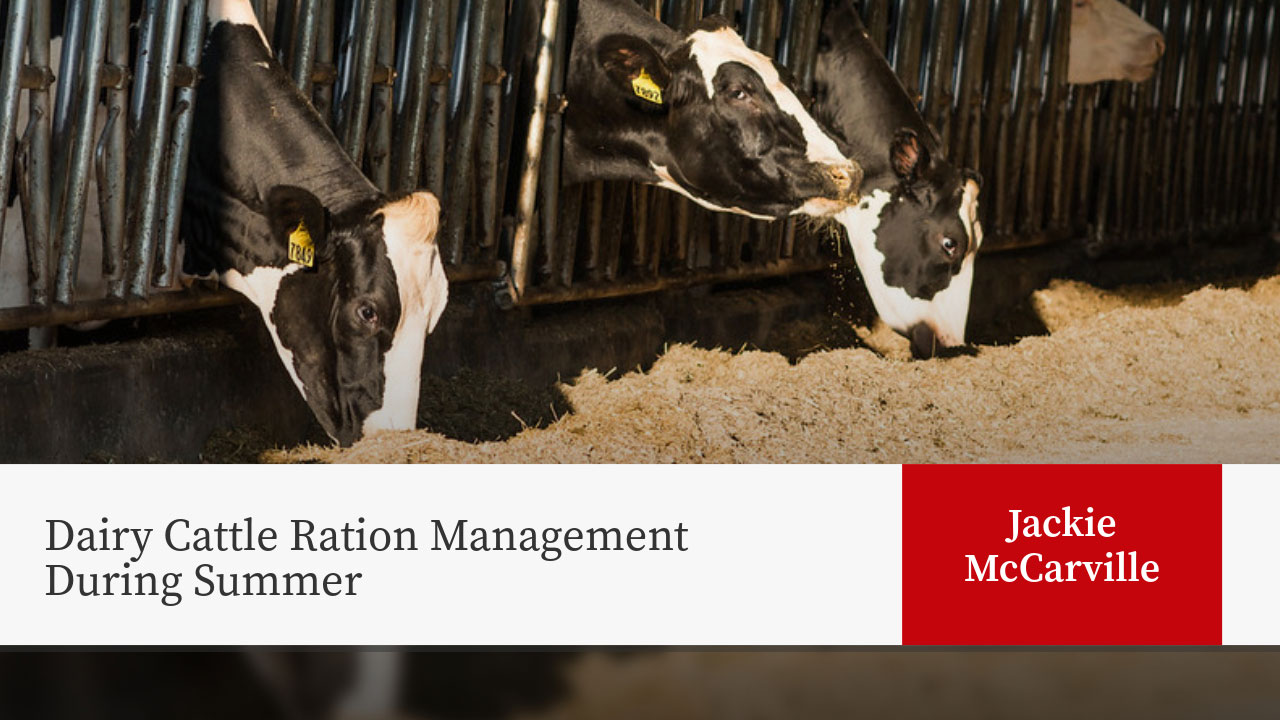
Introduction
Dairy cattle are susceptible to heat stress during much of the summer. The thermo-neutral zone, or the environmental temperatures when cattle don’t expend additional energy to stay warm or cool themselves, ranges from 41°F to 77°F. When the temperature is above this zone, cattle start to respond negatively.
Humidity also interacts with temperature to affect dairy cows. During high humidity, cattle will show signs of heat stress at lower temperatures due to less ability to cool themselves. Dietary adjustments can help maintain nutrient intake and production. This factsheet will cover different nutrients to change in the ration to minimize production losses. Maintaining high quality rations that do not heat is also important and is discussed in another factsheet in this series.
Intake Levels and Fiber/Starch Content
Feed intake monitoring is key to determine when cattle are affected by heat stress and a diet adjustment is warranted. Neutral detergent fiber (NDF) is an important nutrient to ensure proper rumen fermentation. However, fiber fermentation creates more heat compared to fermentation of sugars or starches. Intake level is also an important factor with research showing that cows with higher intakes of a lower fiber diet are more affected by heat stress than cows with lower intakes of a higher fiber diet (West et al., 1998). Small decreases in NDF content along with increases in higher energy feeds (grains, sugar, fats) can help maintain energy intakes. In addition to providing a greater amount of energy, feeding higher quality, highly digestible forages/feeds, that more quickly ferment, is an important strategy to help maintain intakes, by decreasing fermentation heat and rumen fill. Be mindful that replacing fiber with higher energy starch feeds can cause rumen acidosis and lead to additional health issues. A minimum fiber level of 28-30% NDF should be maintained for high producing cows when feeding a high forage ration (>50% forage) with higher levels needed if using high fiber byproducts that do not provide much effective fiber (i.e. soyhulls, wheat midds). Starch levels generally should not exceed 26-28% of DM depending on starch fermentability. Diets should have lower starch levels based on highly fermentable starch feeds (i.e. corn silage, high moisture corn, extruded/steam flaked corn) to help maintain a normal rumen pH and butterfat levels. A blend of slower fermentable starch sources (dry ground corn) and higher fermentable starch sources can help moderate this issue. If adding starch, increasing the level of a buffer (sodium bicarbonate) up to 0.5-1% of dry matter can help maintain rumen pH in addition to adequate fiber levels. The buffer also adds sodium which is needed during heat stress.
Adding Fat to the Diet
Fats are often added to dairy cow diets during heat stress as they do not contribute to heat produced in the rumen while increasing the diet energy content. Some fats can have a negative effect on rumen fermentation and butterfat such as sources high in polyunsaturated fats (vegetable oils; grease; or fat from corn distiller grains). Including a portion of fat from rumen inert sources or higher palmitic/oleic acid blends (Lock and de Souza, 2017) are good options to minimize effects on rumen fermentation and biohydrogenation. Feeding 2- 3% of DM added fat, with a portion from tallow and/or palmitic/oleic acid blend oil, and a portion from rumen inert fat, can help increase the diet energy while minimizing effects on rumen fermentation. A maximum total fat level of 6% of DM is thought to minimize potential negative effects on rumen fermentation and diet economics. Responses to added fat are variable, with some studies showing a positive response and others minimal effect.
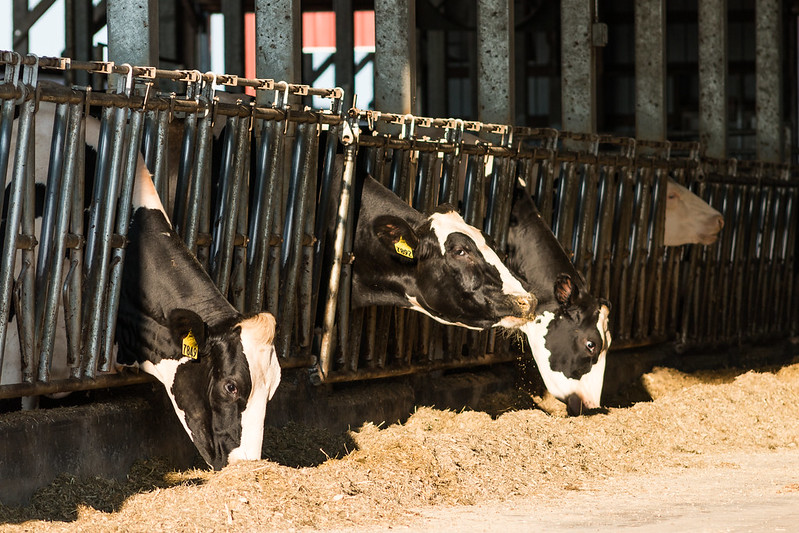
Adjusting Diet Mineral Levels
As animals experience higher temperatures and consume greater amounts of water, they will increase loss of minerals/electrolytes through urination and sweating. While the primary affected minerals are sodium and potassium. Decreased feed intake during warmer periods results in an overall decrease in intake of all minerals/ electrolytes. Therefore, increasing levels of all minerals may be justified. Adjusting levels of sodium up to 0.4-0.6% of DM and potassium up to 1.5-1.6% of DM can help during heat stress (Dairy NRC, 1989).
Increasing magnesium to 0.35-0.4% of DM is required with increased levels of potassium, due to lower magnesium absorption (Greene et al., 1983). Having salt blocks in the feed bunk also allows animals with lower intakes to adjust their electrolyte consumption.
Changes in Feeding Behavior
When making diet adjustments, it is important to watch for changes in the feeding behavior of cattle. Cattle that are experiencing heat stress will decrease their consumption. Diet adjustments, discussed in this publication, can be made to increase the energy density of the diet and mitigate the impact of decreased intake. If fiber level is decreased too much through these diet adjustments, it increases the risk of rumen acidosis.
Acidosis can become a larger concern during times of heat stress compared to times of more temperate weather. This is attributed to changes in feeding behavior as well as physiological responses to heat stress. When a dairy cow is experiencing heat stress the rate of respiration increases in an attempt to expel heat. This process decreases the amount of bicarbonate in the blood (Schneider et al., 1984), which decreases the amount available in saliva to act as a buffer. Drooling also occurs in an attempt to cool the body, reducing the total amount of saliva available for buffering in the rumen. This combined with changes in feeding behavior such as slug feeding, and feed sorting can lead to acidosis.
Cattle may choose to eat during cooler times of the day resulting in one or two large meals instead of several smaller ones throughout the day. Large meals can drop the pH of the rumen, which should be avoided to reduce the risk of acidosis. In order to prevent slug feeding, feed should be delivered multiple times per day and cattle should not be overcrowded. Cattle will also sort out longer particles of feed to select for concentrates. The increase in concentrate intake can increase the pH of the rumen leading to acidosis. Chopping hay particles to less than 2-3” can help minimize sorting.
Alternatively, if there are too many fine particles rumen fermentation will be negatively impacted. A shaker box can be used to determine if the level of physically effective fiber is adequate. Adding water or liquid feeds to drier diets can also reduce feed sorting.
Below are some general recommendations. It is important to work with your nutritionist to make any necessary diet changes based on your farm’s conditions.
Best Management Practices
Monitor intakes and adjust fiber levels if possible
Tracking of intakes is critical to determine how heat stress is affecting cattle and if diet adjustments are needed. Ensure there is adequate fiber for rumen health otherwise changes may cause acidosis. Use of high fiber digestibility forages is suggested to improve intakes and production. Adjusting starch fermentability using a portion of slower fermentable starch may help rumen pH and butterfat.
Additional fat may help maintain milk production
Fat supplements with minimal impact on rumen fermentation may help energy intake and production.
Adjust diet mineral content
With increased sweat and urination, additional sodium and potassium are needed in the ration. If increasing potassium, it is advised to increase magnesium.
Monitor changes in feeding behavior
Monitoring feeding behavior and making adjustments can help reduce the risk of acidosis. Watch for changes in intakes, sorting and slug feeding. Make adjustments to feeding times and fiber length in the diet where possible.
Authors

Jackie McCarville
Regional Dairy Educator – Jackie’s primary focus is dairy operations. She has experience in the private sector in animal nutrition and on dairy farms.
Original Authors
Matt Atkins and Kimberly Schmidt
Original publication date: July, 2020
Revised: October, 2024
References
- Lock, A. and J. de Souza. 2017. Update on Fatty Acid Digestion and Metabolism and Impacts on Milk Production. Proc. of 2017 Tri-State Dairy Nutr. Conf.
- Schneider, P. L. et al. 1984. Influence of dietary sodium and potassium bicarbonate and total potassium on Heat- stressed lactating dairy cows. J. Dairy Sci.
- Schonewille, J.T., L. Ram, A.T. Van’t Klooster, H. Wouterse, A.C. Beynen. 1997. Native corn starch versus either cellulose or glucose in the diet and the effects on apparent magnesium absorption in goats. J. Dairy Sci..
- West et al. 1998. Effects of dietary fiber on intake, milk yield, and digestion by lactating dairy cows during cool or hot, humid weather. J. Dairy Sci.
Download Article



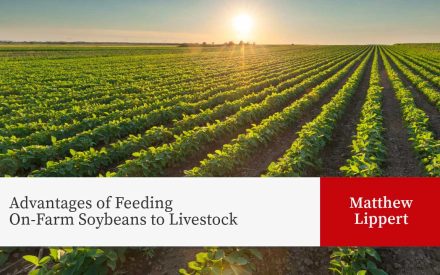 Advantages of Feeding On-Farm Soybeans to Livestock
Advantages of Feeding On-Farm Soybeans to Livestock Top strategies to streamline your milking parlor
Top strategies to streamline your milking parlor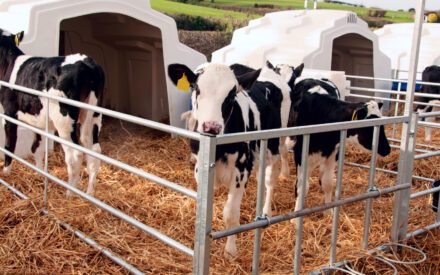 Water: A critical and undervalued nutrient in dairy calves
Water: A critical and undervalued nutrient in dairy calves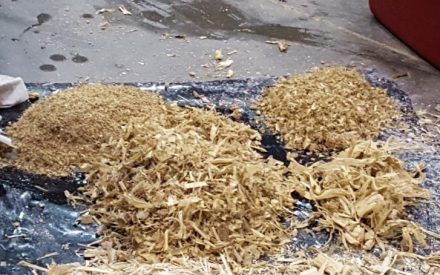 Check Your Corn Silage Processing During Harvest to Ensure Optimal Nutrition
Check Your Corn Silage Processing During Harvest to Ensure Optimal Nutrition


